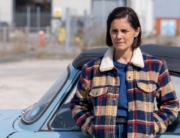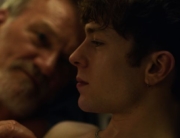Several historical documentaries have been rereleased this month for the 50th anniversary of the Stonewall riots. Joining them is The Queen (1968), which has been recently restored from its original negative by Kino Lorber. It follows contestants and organizers of the 1967 Miss All-America Camp Beauty Pageant in New York City. (According to Roman Polanski, the film was “the toast of Cannes.”) For queer history buffs who want to take a look into the world that gave rise to Pose and RuPaul’s Drag Race, this film will be a real treat.
Viewers will notice its decidedly old-school approach. Documentaries certainly have changed in the last 50 years. The Queen utilizes very little editing and none of the graphics we have come to be so accustomed to these days. Just good ol’ cinema verité: the camera and interviewers follow pageant contestants around in the days leading up to the competition and let us peek into this world of competitive drag as if we are little kids sitting on the floor watching the adults do their thing.
Apparently the producer decided to cut out all of the questions the interviewers asked the contestants. In this way the interviews don’t come off as such, which gives the film that “eavesdropping kid” feeling as drag queens and their coaches bicker over rehearsals, costumes, and makeup. There are also quieter moments of queens lounging around in hotel rooms discussing their experiences of being queer. It’s fascinating to think that for many people watching this film in 1968, this was their first window into this scene. It’s equally fascinating to note that not much has really changed in how gay men and trans women—they call each other “girl”—discuss how they identify as men on the outside and women on the inside. Trans identities are in no way a recent phenomenon.
The most resonating moment occurs in the last five minutes and is one reason why the movie has remained a pioneering drag film to this day. During the previous hour, all of the featured contestants were well-composed, polite, witty, and compliant with the etiquette expected of them by the organizers of the competition. But after the winner is crowned, the gloves come off. The pageant then devolves into an all-out shade-throwing brawl.
Notably contestant Crystal LaBeija calls out the pageant’s racial biases. With this in mind, consider that the judges were mostly white men, including Jim Dine, Larry Rivers, George Plimpton, Terry Southern, and Andy Warhol. The winner is a petite blond who has the beautiful Cover Girl look of the time, whereas LaBeija and several other queens felt the contestants were not judged for their costumes, hair, makeup, and performances. LaBeija would go on to be one of the founders of house culture in New York, where drag performers of color flourish to this day. To catch up with drag houses, watch the recent documentary Kiki to see how far they have come. Watching the final moments of The Queen is seeing a literal spark that changed history.

















Leave A Comment